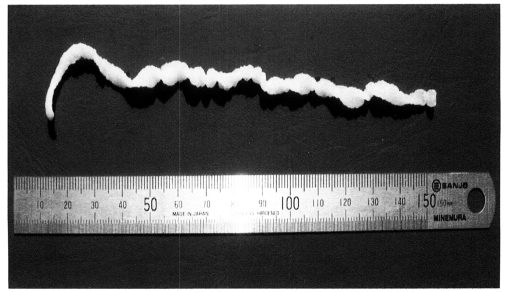A case of breast sparganosis
Article information
Abstract
A 29-year-old Korean woman visited the Department of Surgery in MizMedi Hospital with a palpable itching mass on the right breast that had existed for the past 7 months. She had no history to eat either frogs or snakes, but had the history of drinking impure water. Sonography revealed a serpiginous hypoechoic tubular structure associated with partial fat necrosis in breast parenchymal layer and subcutaneous fat layer. It also revealed oval cystic lesions. At operation, an ivory white opaque ribbon-like worm that measured 16.5 cm in length and 0.5 cm in width was extracted. Anti-sparganum specific serum IgG level in the patient's serum (absorbance = 0.71), measured by ELISA, was found to be significantly higher than those of normal controls (cut off point = 0.21). Sonography and ELISA appear to be helpful to diagnose sparganosis. Breast sparganosis is rarely found throughout the world.
Sparganosis is an infection caused by sparganum, a plerocercoid larva of a cestode, beloging to the genus Spirometra. Sparganosis is a worldwide disease, but the major endemic areas are China, Japan, Taiwan, Korea, Vietnam, Thailand, and other Southeast Asian countries (Sun, 1999). The final host are cats and dogs. The first intermediate host is a crustacean or copepod of the genus Cyclops, when the second intermediate hosts such as frogs, snakes, birds or small rodents eat an infected Cyclops, the larva penetrates the intestinal wall and migrates into various organs and tissues, where it develops into the plerocercoid larva (Moreira et al., 1997). The most important route of infection in Korea is through eating raw snakes, followed by drinking contaminated water with infected Cyclops and by eating raw frogs or other kinds of raw flesh (Min, 1990). Sparganum was commonly found in the abdomen (28.1%), urogenital organs (22.2%), extremities (17.8%), central nervous system (11.9%), chest (10.4%), orbital region (8.1%), neck and oral cavity (1.5%) in descending order (Min, 1990). Breast is a rare site of infection.
A 29-year-old Korean woman visited the Department of Surgery in MizMedi Hospital with a palpable itching mass on the right breast that had existed for the past 7 months. On physical examination, a lump with mild tenderness was palpated at the lower outer quadrant of the right breast. She had no history to eat either frogs or snakes, but had the history of drinking impure water. Sonography revealed a serpiginous hypoechoic tubular structure associated with partial fat necrosis in breast parenchymal layer and subcutaneous fat layer (Fig. 1A). It also revealed oval cystic lesions (Fig. 1B). At operation, an ivory white opaque ribbon-like worm that measured 16.5 cm in length and 0.5 cm in width was extracted (Fig. 2).

Breast sparganosis. Sonography shows a serpiginous hypoechoic tubular structure (A) and oval cystic lesions (B).
The patient's serum was examined for the level of anti-sparganum IgG antibody by micro-ELISA. Antigen was prepared from the spargana collected from naturally infected snakes (Rhabdophis tigrinus tigrinus). Human sera were diluted to 1:400, and alkaline phosphatase conjugated goat anti-human IgG (Fab specific; Sigma, USA) was diluted to 1:5,000. The optical density was read at 405 nm. Anti-sparganum specific serum IgG level in the patient's serum (absorbance = 0.71), measured by ELISA, was found to be significantly higher than those of normal controls (cut off point = 0.21). No cross-reaction to other helminthes, such as cysticercus of Taenia solium, Clonorchis sinensis and Paragonimus westermani, was found (Table 1).

IgG antibody levels of the patient’s serum and normal human sera against the extract of four different antigens, measured by ELISA
The hypoechoic tubular structure revealed by sonography was regarded as a remnant formed by an active moving of sparganum (Hong et al., 1989; Chung et al., 1995). The tubular structure appeared to have just undergone the process of active healing after the worms pass through (Hong et al., 1989).
When located in the breast, sparganosis has generally been diagnosed as mastitis or cancer (Moreira et al., 1997). Therefore, sonography and ELISA appear to be very helpful to diagnose sparganosis. In fact, breast sparganosis is rarely found throughout the world.
